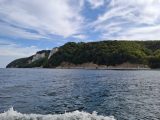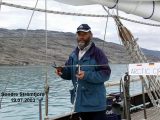(DZ- sailing and rowing boat with 2 masts for 10 oars
This voyage was prepared for a particularly long time – as many as two years. This was not due to the particular difficulties piled up for the crew, but to the matching of the schedules of the people who make up the crew. The DZ voyage to Rügen itself is in fact nothing new, trails were paved by sailors from HOM Szczecin back in the early 1990s. It is an interesting body of water for tourism and navigation, and the infrastructure for sailors even encourages to sail there. The cruise was made possible thanks to the receipt of the City of Gdynia Award “Eternally Young” named after Aleksander Doba by Captain Henryk Wolski. The financial prize of PLN 15,000 was used to prepare the yacht for the DZ and to carry out the expedition.
Premise of the expedition:
The three-week voyage was divided into two independent stages, whose common denominator was the figure of Captain Henryk Wolski. In the first, one-week stage, the Captain’s family sailed on board, and the expedition had a three-generation character. It was a family-oriented, somewhat leisurely stage, although a specific goal was set before the crew to deliver the yacht to Stralsund, which was achieved. This stage was merely a preparation for the main part of the expedition, so that the other crew would not waste any time getting there and could concentrate on carrying out the complex and ambitious plan.
The second stage, which lasted two weeks, was the main part of the expedition, and its goals were characterized in detail in the competition application presented to the Jury of the Kolosy Event during the last edition of the event in March 2024. Our cruise was an expedition with an archaeological subtext, with the intention of reaching archaeological sites in Ralswiek and Kap Arkona. The crew included a doctor of archaeology, who was a source of substantive knowledge, and Captain Henryk Wolski was a goldmine of historical knowledge about the ancient Slavs, their expeditions, conquests and customs.
Achieving the goals of the expedition:
The expedition objectives presented in the application presentation identified two main goals and several side goals. The main goals were presented as follows:
Reaching archaeological sites located near the town of Ralswiek, the probable site of the Battle of Svold from 999, and sailing along the Ran trade route, of which Altwarp and Stralsund were important points.
Reaching Kap Arkona – a cape on the northern edge of Rügen, the most important Rani stronghold and their former fortress. Arkona was also the center of the cult of the Slavic god Świętowit (Polabian: Svątevit). Today, there is not much left of the former power of the Slavs, but it is these traces that we want to examine, document, and use the collected material for a popular science publication.
The voyage and the crew
The voyage was divided into two stages, both of which were commanded by Captain Henryk Wolski. The entire expedition was non-commercial in nature, the first stage was of a family nature, as the captain’s daughter and granddaughters were on board, and the second stage was attended by Henryk Wolski’s friends. The crew of this stage consisted of: Henryk Wolski, 73, Jarosław Gabryelski, 53, Łucja Wolska, 43, Stefan Liersch, 50, Matylda Maj, 16, Jędrzej Gabryelski, 13, Lukas Wolski, 15, Lia Wolski, 13.
From Szczecin, the first crew sailed to Stralsund, where the team of the exploration stage boarded the dezetta. This expedition was attended by older sailors, the oldest being 79, while the average age was over seventy, but on part of the expedition young sailors also sailed, completing the intergenerational mosaic. This time the crew was as follows: Henryk Wolski, 73, Michał Jósewicz, 74, Przemysław Wielowiejski, 67, Michael Lups, 68, Marek Słodownik, 64, Józef Garcarczyk, 79, Michał Słodownik, 23, Avory Pradzyński, 25.
We decided to visit waters inaccessible to larger yachts, using the advantage of our dezetta in the form of a shallow draft. The plan of the cruise was to sail through internal waters from Szczecin via Wolgast and Penemuende to Stralsund, then explore the internal waters of Rügen, stay in Ralswiek, where the wreck of the ship “Bialy Kon” was found years ago, and then visit the island of Hidensee. There, the decision was to be made regarding a possible sailing around Cape Arkona. Because the wind was strong – 50B, but from a favorable SW direction, the captain decided to set off on the route in open waters. Despite the strong wind, there were no waves, because the yacht kept very close to the shore. Thanks to this, we had a close look at the cliffs of Arkona and the escarpment, on which centuries ago there was a stronghold of the Rani, i.e. ancient Slavs, as well as the beautiful cliffs of Sagard, which are part of the national park. The last stretch, from Cape Koenigsstuhl, proved to be quite a challenge, as we were exposed to sailing against the wind and a steep short wave as we sailed out into uncharted waters. From Sassnitz, we sailed along the eastern shore of Rügen to the island of Ruden, where we obtained permission for a short stop, and from there to Penemünde and return the same way to Szczecin.
At Cape Arkona, we tried to visit the remains of the stronghold of the Rani, but it turned out to be inaccessible to tourists. We collected materials, made photographic documentation, and currently our collection is being systematized and will be used for publications and multimedia presentations prepared for the needs of promotional meetings aimed at the sailing community.
Direct observation of the settlement and discussions with local researchers lead to the conclusion that the Cape Arkona settlement is a unique archaeological site of the western Baltic Sea, but it requires urgent and comprehensive archaeological research because it is currently threatened by further destruction due to the landslide into the sea of an approximately 45-meter high cliff, which has remained without reinforcement/securing since the discovery of the settlement in the 2nd half of the 19th century. At the time of the reconnaissance, no archaeological investigations were carried out, and no infrastructure necessary for the operation of the archaeological mission was found. From the sea, at the edge of the cliff, a cross-section of a powerful defensive wooden and earth rampart is clearly visible, which was built around 1100 as a result of the expansion of the hillfort. The foreground of the hillfort is mostly used for agricultural purposes, intersected by a tourist trail and an access road; there is also a lighthouse used for tourist and commercial purposes.
Both the land excursion and the cruise stage allowed observation, both from land and from the sea, of the state of preservation of the 1st half of the 9th century stronghold, located on the cliff edge of the Arkona peninsula. The unique nature of this object results from the important role that this stronghold played in the area of Western Slavonia. It was the most important political, commercial, military and sacral centre of the West Slavic Rani. Its importance is confirmed by written sources of the time, especially the account of the Danish chronicler Saxo Grammaticus. He drew his information directly from Archbishop Absalom, who in 1168 participated in the capture of Arkona, personally directing the destruction of the temple and the statue of Świętowit.
Yacht and living conditions
We sailed on DZ “Sum” POL 3144 from the Szczecin JK AZS. Despite 38 seasons under her belt, the yacht looks great, mainly thanks to the efforts of Michał Josewicz, her club caretaker. DZ performed admirably in the cruise; she is a yacht that is easy to operate and reliable. The division of the sails into two masts makes it easy to select the optimal sail area. The shallow draft allows her to reach places that larger yachts cannot reach. Even before the voyage began, it was clear that it was not going to be easy. DZ is a yacht without a cabin, so we were directly exposed to the vagaries of the weather. Thanks to a special tent rolled out over the deck, we could all sleep on deck at night in harbours, which for many of us was a return to our youth and camping standards from many years ago. Although we had traditional tents, not every port allowed us to set up camp, and it was more convenient that way. Thanks to boards folded out on benches, we created a two-story sleeping area for the crew. The drawback was the daily cleaning, which required iron discipline in controlling one’s private belongings, but the crew quickly achieved a routine in this area that allowed for efficient preparation of the yacht for sailing. Sleeping on the floor, under the benches of the companions was comfortable enough, it was a bit difficult to get out of such a berth, but in the rain, it was completely dry, the first storm was taken by the “sleepers” from the upper floor.
We cooked on a two-burner tourist stove powered by disposable cartridges, which were easy to store. High-calorie fuel allowed us to prepare cooked food regardless of the conditions, only in port of course. The harbour authorities were exceptionally friendly towards us and allowed us to put the crates with the galley facilities on the quay, where we could cook in peace. The menu strongly referred to the atmosphere of the 70s: canned goods, semi-finished products, often also ready-to-eat products that only required heating. The crew ate on the shore or on the yacht, depending on the conditions, sometimes we used tourist tables. There were no comforts, but we didn’t choose this type of yacht for that either.
Safety and maneuvers
The crew had standard safety measures, life jackets and lifebuoys. The engine is an essential element of the yacht’s equipment on this body of water, in addition to manoeuvres in tight ports, it also supported sailing in narrow passages of fairways in unfavourable weather conditions and was also used on the high seas to sail upwind. We also had four oars on our boat for port maneuvers in light winds. We entered Breege on oars in a ceremonial manner, arousing considerable interest among local sailors and onlookers.
During the sailing, we used a full set of sails, and when the wind increased, we sailed without a mainsail. After sailing out to open waters between Rugia and the island of Ruden, when the wind was 6°B, we sailed in full close reach on the jib alone. DZ is an excellent yacht for sailing even in these conditions, although waves sometimes broke on board, the crew never felt threatened by the conditions. In reaching winds we set the jib and mainsail, this set provided a sufficiently large sail area and also ensured calm sailing, without sharpening the safety and manoeuvres.
During the sailing, we used a full set of sails, and when the wind increased, we sailed without a mainsail. After sailing out to open waters between Rügen and the island of Ruden, when the wind was 60B, we sailed in full upwind on the jib alone. DZ is an excellent yacht for sailing even in these conditions, although waves sometimes broke onto the deck, the crew never felt threatened by the conditions for a moment. In reaching winds we set the jib and mainsail, this set provided a sufficiently large sail area and also ensured calm sailing, without the luffing caused by the mizzen placed close to the stern.
Navigational aids
Rügen is an interesting water body for navigation, constituting an excellent training ground for navigators. Numerous narrow fairways, leading lights, interesting approaches to ports mean that you have to be careful. Every time you stray from the precise fairway results in immediate trouble. Even sailing without a centerboard, we were already shuffling on the sand a few meters from the buoy, and many places marked with cardinal buoys hide stone reefs. This is a difficult water body, but excellent for sailing, interesting nautically and demanding navigationally.
Our cruise was not a sailing feat, but the yacht’s record speed was 7.2 knots, which for an 8.5-meter-long yacht can be considered a very satisfactory result.
What is worth seeing on Rügen?
It is an interesting place for tourists, but during a short cruise you have to choose from many attractions. The local resorts are very interesting: Binz, Seellin or Putbus. Different from our seaside towns, without the shacks and cheerful dance music. Trimmed trees, renovated white facades of houses, cleanliness and elegance, it is really worth seeing. An interesting fact is Prora, a Nazi holiday home for 20 thousand holidaymakers, which is a kind of memento. Stralsund tempts with the history of a Hanseatic city and the modern Oceaneum, and it is also impossible to miss the wonderfully restored “Gorch Fock” from 1933. Less known, but no less interesting, are also small ports with their specific holiday atmosphere of no rush and traditional sailing elegance. Shaprode, Breege, Kloster on the island of Hidensee allow us to travel back in time by several decades, to a place where old thatched houses reign, cobblestones on the streets and small Protestant churches with concerts. Undoubtedly, a place that cannot be missed is Cape Arkona with two lighthouses, the recently opened secret bunkers of the GDR Navy and the sea rescue museum.
Conclusions
The financial award accompanying the “Forever Young” Award named after Aleksander Doba contributed significantly to reducing the costs of the entire expedition, thanks to it we were able to equip the yacht with all the planned elements affecting safety, regulate port fees on an ongoing basis, and provide the crew with appropriate living conditions on the yacht by paying port fees on an ongoing basis. It is worth noting that Rügen is a relatively expensive water body, the cost of an average marina was around 30 euros per night, hence the funds obtained significantly supported our budget. Thanks to additional budget support, trips to the Oceaneum in Stralsund, Jasmud National Park, and the bunker complex at Cape Arkona became available.
The expedition took place according to the planned schedule, all its goals were achieved, and the course showed that it is an interesting way to explore and acquire promotional materials. Thanks to the diverse interests of the crew members, the cruise created an interesting opportunity to exchange sailing experiences, enrich historical and archaeological knowledge and was an inspiration for further research. The fruits of the expedition are also numerous information materials, a rich photographic archive and documentation, which will be used to prepare further public appearances and publications spread over time. Thanks to the Award, we were able to fully implement the planned cruise plan, and the acquired financial resources significantly facilitated its full implementation. The inspirational nature of the expedition, its rich harvest and the atmosphere on the yacht encourage us to expand our search in the discussed area and we will probably soon start another sailing expedition with a scientific subtext, the aim of which will be to search for the legendary Vineta – a town and port with a lighthouse located near the mouth of the Oder.
MAS


